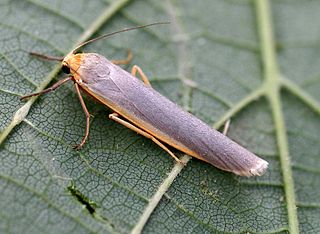Wittia is a genus of moths in the family Erebidae.
Dolgoma is a genus of moths in the family Erebidae. The genus was erected by Frederic Moore in 1878.

Manulea complana, the scarce footman, is a moth of the family Erebidae. The species was first described by Carl Linnaeus in his 1758 10th edition of Systema Naturae. It is found throughout the Palearctic region.

Wittia sororcula, the orange footman, is a moth of the family Erebidae. The species was first described by Johann Siegfried Hufnagel in 1766. It is found in Europe, Anatolia and further east across the Palearctic to southern Siberia and the Amur basin to China.

Manulea lutarella is a moth of the family Erebidae. It is found in North Africa through Central Europe up to the area surrounding the Amur River and Sakhalin. In the north, it is found up to Scandinavia, Komi Republic in European Russia, Vitim river in Siberia.
Manulea pseudocomplana is a moth of the family Erebidae. It is found from central and southern Europe to Ukraine, Turkey and Iran.

Manulea pygmaeola, the pigmy footman, is a moth of the family Erebidae. It is found in the western half of the Palearctic realm, east to Altai.

Manulea (Setema) cereola is a moth of the family Erebidae. It is found in Fennoscandia, the Baltic States, European Russia as well as the Alps and Urals. The species was first described by Jacob Hübner in 1803.
Manulea costalis is a moth of the family Erebidae. It is found in Albania, Bulgaria, Serbia, North Macedonia, Greece and on Crete, as well as in Turkey and Armenia. on the Andamans and from India to Myanmar.
Manulea flavociliata is a moth of the family Erebidae. It is found in north-eastern Kazakhstan, southern Siberia, the Russian Far East, Mongolia, China and Korea.
Manulea pseudofumidisca is a moth of the family Erebidae. It is found in Russia, North Korea and China.
Manulea affineola is a moth of the family Erebidae. It is found in the Russian Far East (Primorye), Korea, China (Shaanxi) and Japan.
Manulea kansuensis is a moth of the family Erebidae. It is found from Russia (Transbaikalia), through Mongolia to Gansu, China.
Manulea nankingica is a moth of the family Erebidae. It is found in the Russian Far East (Primorye), China (Jiangsu), Korea and Japan.
Manulea ussurica is a moth of the family Erebidae. It is found in the Russian Far East (Primorye), China and Korea.
Manulea atratula is a moth of the family Erebidae. It is found in Russia, Mongolia and North Korea.
Manulea hyalinofuscatum is a moth of the family Erebidae. It is found on Wrangel Island and in Chukotka.
Manulea nigrocollare is a moth of the family Erebidae. It is found in Russia.
Manulea vakulenkoi is a moth of the family Erebidae. It is found in Russia.
Manulea hunanica is a moth of the family Erebidae. It is found in China.





